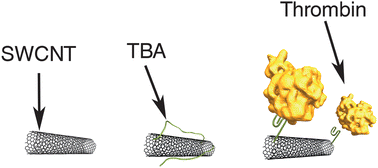Solid-contact potentiometric aptasensor based on aptamer functionalized carbon nanotubes for the direct determination of proteins
Abstract
A facile, solid-contact selective potentiometric aptasensor exploiting a network of

* Corresponding authors
a
Department of Analytical and Organic Chemistry, Universitat Rovira i Virgili, Tarragona, Spain
E-mail:
fxavier.rius@urv.cat
Fax: +34 977 558 446
Tel: +34 977 559 562
b Department of Chemical Engineering, Universitat Rovira i Virgili, Tarragona, Spain
c Institució Catalana de Recerca i Estudis Avançats, Barcelona, Spain
A facile, solid-contact selective potentiometric aptasensor exploiting a network of

 Please wait while we load your content...
Something went wrong. Try again?
Please wait while we load your content...
Something went wrong. Try again?
A. Düzgün, A. Maroto, T. Mairal, C. O'Sullivan and F. X. Rius, Analyst, 2010, 135, 1037 DOI: 10.1039/B926958D
To request permission to reproduce material from this article, please go to the Copyright Clearance Center request page.
If you are an author contributing to an RSC publication, you do not need to request permission provided correct acknowledgement is given.
If you are the author of this article, you do not need to request permission to reproduce figures and diagrams provided correct acknowledgement is given. If you want to reproduce the whole article in a third-party publication (excluding your thesis/dissertation for which permission is not required) please go to the Copyright Clearance Center request page.
Read more about how to correctly acknowledge RSC content.
 Fetching data from CrossRef.
Fetching data from CrossRef.
This may take some time to load.
Loading related content
